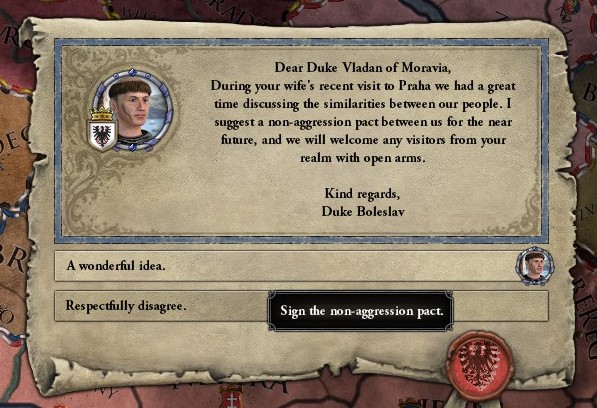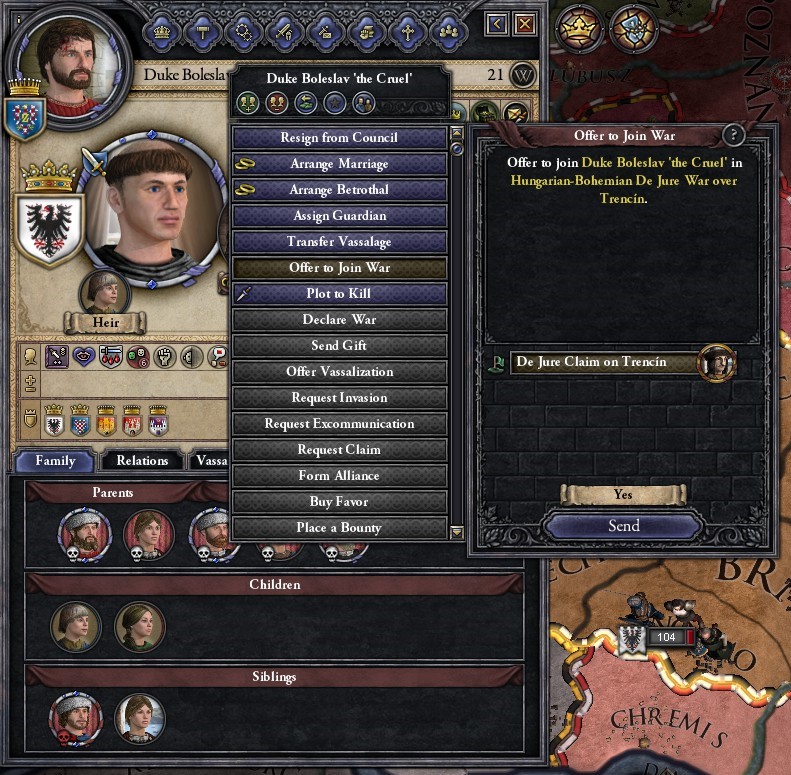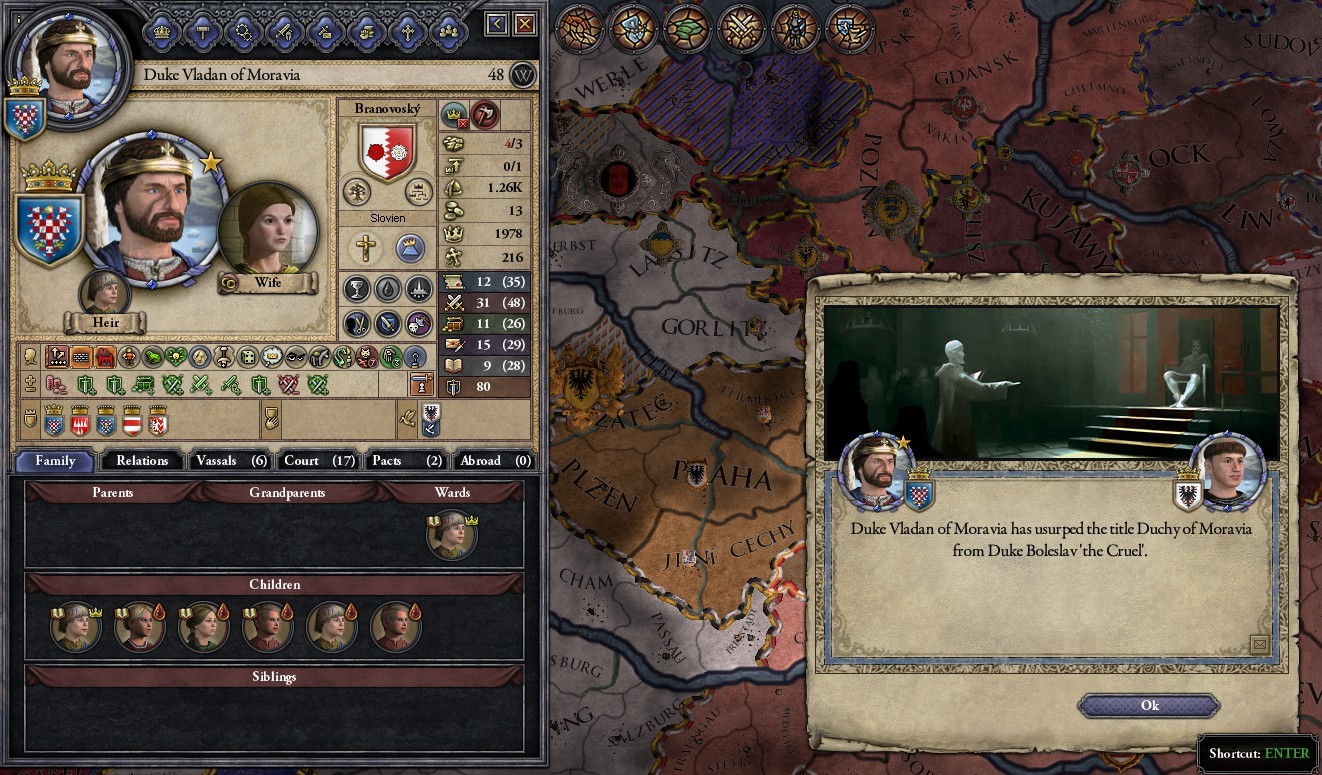Chapter 3: Conquests; Foreign and Domestic (953-963)
Vladan gathered his court and advisors and moved his center of power to Olomouc, the economic center of Moravia. Situated far from the Hungarian border and on the Morava river, Olomouc had developed as the capital of the region under the Mjomirids of Great Moravia and benefited from proximity to the Mjomirid capital. When the empire fell and the capital sacked, Olomouc became the destination for surviving Moravian nobles. The city had an established infrastructure and networks of communication throughout the region which made it the ideal position for Vladan to assert control.

As his first order of business Vladan granted a loyal commander, Vladimil of Rajhrad, the gord of Opava, the small fortified settlement which governed the wider county. Lacking any development of a city or infrastructure and mostly inhabited by sparse communities of tribes, it made little sense for Vladan’s new centralized government to directly control the county. Vladan also raised Vladimil to the marshal of his army in recognition of his contributions.
Vladan needed gold. He already owed the Jewish community of Bohemia huge sums and his newly conquered duchy had to recover from war. While he wanted to immediately set his sights on Hungary he had to wait and allow his coffers and levies to build up. Vladan was not a patient man yet not much could be achieved now.
Boredom did offer its perks, however. Needing his share of excitement and *ahem*
conquest, Vladan made a move on Slavena, a homely but kind and loving woman in his court who had occasionally shown interest in him. Previously Vladan had no time for paramours but now things were different.
Indeed it is good to be the Duke.
In mid-954, Vladan received a notice from the leader of the Fighter’s Guild, urging him to take up arms in defense of a young Duke in Italia facing a revolt from within his ranks. Always eager for a fight, Vladan raised his troops and began to march.
While on campaign in Italia Vladan’s council received notice that Boleslav of Bohemia sought to eliminate any further hostilities between Bohemia and Moravia and to encourage the reestablishment of free-trade between their peoples. While Vladan may have sneered at this request, his councillors saw the wisdom in keeping Bohemia close for economic reasons and even potentially seeking an alliance to keep Moravia strong in the face of the Hungarians. Besides, Vladan wasn’t at court. Better to ask for forgiveness than permission, even from a great warlord.

Vladan arrived outside of Pavia, the capital of the upstart vassal rebelling against his liege. While the vassal’s troops were up sieging in the mountains Vladan knew it much wiser to set up for a long siege than to try to attack an entrenched foe in the mountains. This much he learned from the intense losses the Hungarians faced while encountering his army in Trencin. While he and his men lost that battle, hundreds of Hungarians perished while only a few dozen of his men lost their lives.
Back at home in Olomouc Vladan’s wife passed away. A minor infection ran rampant and despite the court physician’s help, Luitgarde’s body could not handle it. While the Duke and Duchess were not madly in love, it was still a blow to the family’s morale. The matriarch of the next line of Branovoskýs was dead before most of her children even reached adulthood.
When Vladan and his army finally breached the walls of Pavia all hell broke loose. His soldiers began indiscriminately raping and pillaging all who stood in their way. They had been raised, marched for a month across mountainous terrain and then dropped down for a siege without even a battle to sate them. These troops were bloodthirsty. Vladan couldn’t blame them. While he had no interest in joining, they were far from home and bored. He let them sack the city.
Bored of sieging, Vladan led his troops into battle. While a dangerous move to cross a river into battle, all of Vladan’s flanks were led by competent commanders and he had the numerical advantage. When they met the enemy army Vladan realized only the rebelling vassal commanded a part of the army. Vladan maneuvered his flanks to surround the enemy and sank their claws. The battle won the war and once again Vladan proved his battle prowess. Now for the long march home.
When Vladan reached home he learned of the non-aggression pact with Bohemia and his wife’s passing. More troubled by his incomplete family, Vladan began his search for a new Duchess. Vladan, now aged 50, desired more a companion than someone to give him heirs or an alliance. He met with Alda, a Princess from the former ruling dynasty of Italy, who agreed to wed him and move to Olomouc.
Vladan’s French chancellor returned with news of a claim to Trencin, the site of Vladan’s greatest defeat but a needed and valuable county. When the time was right for war, Vladan now had a claim to Nitrava and Trencin.
In 956, Vladan’s eldest daughter Miloslava came of marrying age. He quickly arranged a marriage with the young Ban of Slavonia in Croatia. Tightening his ties with the Southern Slavs would strengthen his position.
Vladan’s ally, the Arletian King in Provence, called upon his help in attacking the West Francian Carolingians. Always itching for war, Vladan gathered his men and began another long march.
Another daughter of Moravia came of age in 960 and Vladan sent her off to court the Doux of Calabria in Sicily. Another valuable alliance for Vladan and Moravia.
While off at war in West Francia it seems the heretic son of Vladan, similarly named Vladan and a disgrace to the name, had some very unsavory relations with a teenager in the realm, resulting in a bastard son. A stain on the dynasty further adding to the shame brought by his heresy.
Vladan knew he needed more land and more soldiers before he could take on the swarms of Hungarians to his south. Just north lay one of the last pagan bastions of Poland. Vladan knew he could make the land profitable and a source for soldiers. Moravia was ready for expansion.
































































